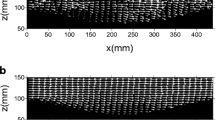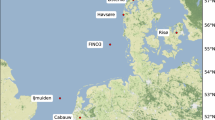Summary
The vertical movements caused by friction and orography influence the changes of atmospheric pressure. In the present paper, this problem is attacked by means of a new expression of the vertical velocity component wh at the top of the planetary boundary layer, \({{\overline{w}}_h={\overline{A}}[grad {\overline{z}}_0,{\overrightarrow{V}}}_g]+{\overline{B}} (grad{\overline{z}}_0{\overrightarrow{V}}_g)+{\overrightarrow{C}}\Omega_g\) where Ā, ̄B, and ̄C are coefficients depending on the eddy turbulent viscosity v (̄z) and on the roughness of the terrain ̄z0 = z0–H, defined as the difference between the height of the obstacle z0 (x, y) above sea level and the smooth general raise H of the terrain over a fixed region; ⃗Vg is the geostrophic wind vector, Ωg is the relative geostrophic vorticity.
The first term of the above formula gives the vertical velocity component in the case of a wind blowing parallel to an obstacle. This effect may be of the same magnitude as the rest of the terms. Ā, ̄B, and ̄C are examined as parameters giving certain weights to the influence of orography and friction. The conclusion is drawn that for a more accurate assessment of the frictional and orographic influences on the atmospheric pressure variations, one should estimate the changes of Ā, ̄B, and ̄C.
Zusammenfassung
Die durch Reibung and orographische Hindernisse verursachten Vertikalbewegungen beeinflussen die Luftdruckänderungen. In der vorliegenden Arbeit wird dieses Problem mittels eines neuen Ausdruckes fur die vertikale Geschwindigkeits-komponente wh an der Obergrenze der planetarischen Grenzschicht in Angriff genommen: \({{\overline{w}}_h={\overline{A}}[grad {\overline{z}}_0,{\overrightarrow{V}}}_g]+{\overline{B}} (grad{\overline{z}}_0{\overrightarrow{V}}_g)+{\overrightarrow{C}}\Omega_g\) Ā, ̄B, und ̄C sind Koeffizienten, die vom turbulenten Reibungskoeffizienten and von der Rauhigkeit des Terrains ̄z0 = z0–H abhängen. Letztere ist definiert als Differenz zwischen der Höhe des Hindernisses and dem geglätteten Anstieg H des Terrains über einem bestimmten Gebiet. ⃗Vg ist der geostrophische Windvektor, Ωg die relative geostrophische Vorticity.
Der erste Term obiger Gleichung drückt die vertikale Geschwindigkeitskomponente für den Fall eines parallel zum Hindernis wehenden Windes aus. Dieser Effekt kann von derselben Größenordnung wie die übrigen Terme obiger Gleichung sein. Ā, ̄B, und ̄C werden als Parameter untersucht, welche den Einflüssen von Orographie and Reibung ein bestimmtes Gewicht geben. Als Schlußfolgerung steht fest, daß zu einer besseren Abschätzung des Reibungs- and des Gebirgseinflusses auf die Luftdruckschwankungen die Änderungen von Ā, ̄B, und ̄C berechnet werden müssen.
Similar content being viewed by others
References
Bolin, B.: On the Influence of the Earth's Orography on the General Character of the Westerlies. Tellus 2, 184–195 (1950).
Charney, I. G., and A. Eliassen: A Numerical Method for Predicting the Perturbations of the Middle Latitude Westerlies. Tellus 1 (2), 38–54 (1949).
Kasahara, A.: The Influence of Orography and the Global Circulation Patterns of the Atmosphere. NCAR Manuscript No. 424, Boulder, Colorado, 1967.
Kibel, I. A.: Introduction to the Hydrodynamical Methods for a Weather Forecast. Moscow, 1957.
van Dyke, Milton: Perturbation Methods in Fluid Mechanics. New York-London: Academic Press, 1964.
Monin, A. S.: Dynamic Turbulence in the Atmosphere. Izvestia AN USSR, Ser. Geophys. and Geograph. 14, No. 3, 232–254 (1950).
Monin, A. S., and S. S. Zilitinkevitch: Planetary Boundary Layer and LargeScale Atmospheric Dynamics. Report Study Conference on the Global Atmospheric Research Programme. W. M. O., 1967.
Mussaeljan, S. A.: Planetary Orographic Waves in the Western Stream. Voprosy Dynamicheskoi Meteorologii. Izvestia AN USSR, Moscow, 1960.
Sawyer, J. S.: The Introduction of the Effects of Topography in the Methods of Numerical Forecasting. Quart. Journ. Roy. Met. Soc. 85, 31–43 (1959).
Author information
Authors and Affiliations
Rights and permissions
About this article
Cite this article
Godev, N. The Introduction of the Effects of Orography and Friction into Methods of Numerical Forecasting. Arch. Met. Geoph. Biokl. A. 19, 29–46 (1970). https://doi.org/10.1007/BF02274640
Received:
Revised:
Published:
Issue Date:
DOI: https://doi.org/10.1007/BF02274640




